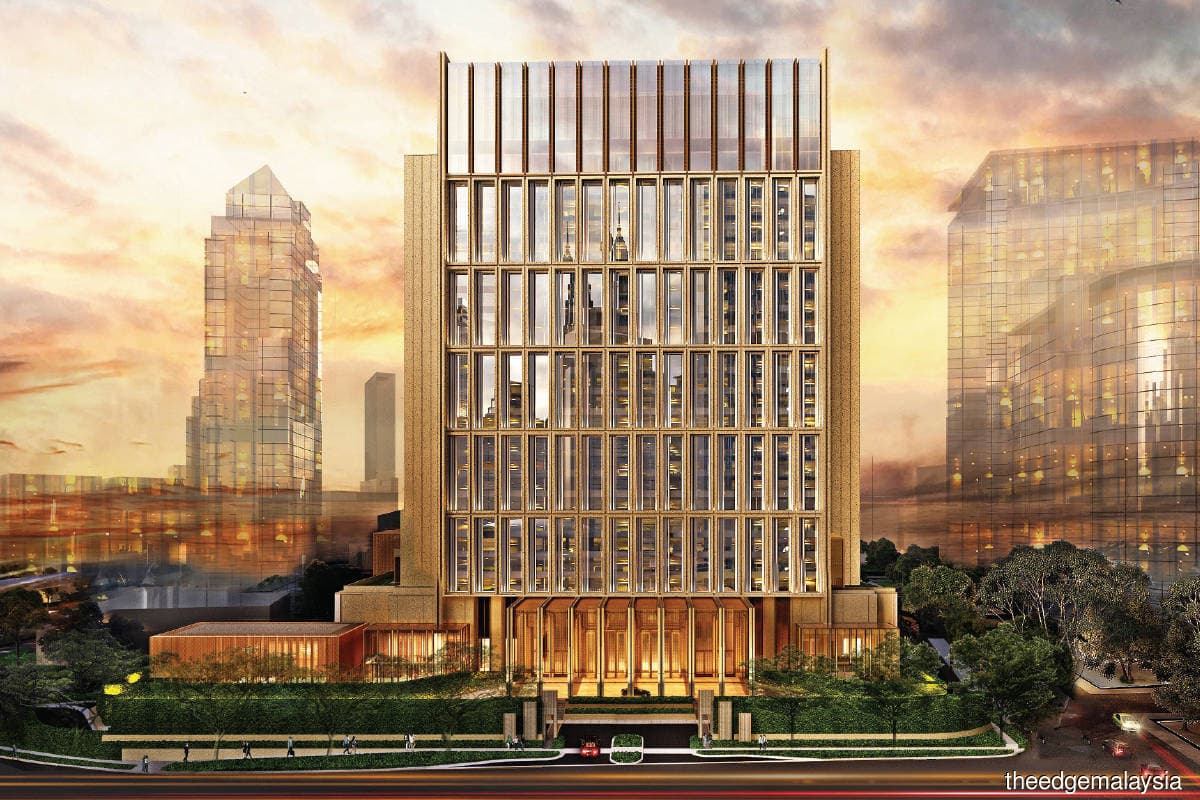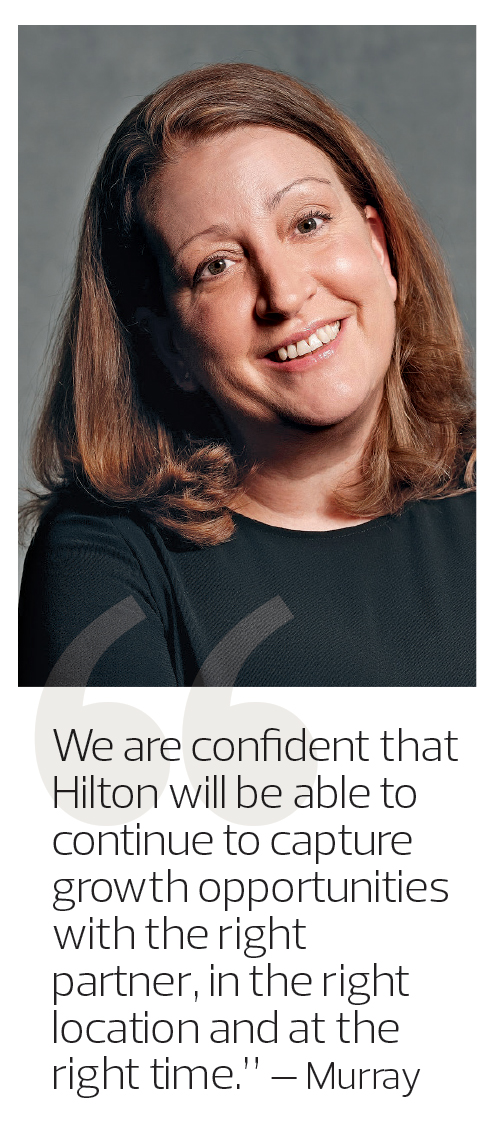
This article first appeared in The Edge Malaysia Weekly on August 14, 2023 - August 20, 2023
US-based hospitality chain Hilton Hotels & Resorts has confirmed the opening of seven new hotels in Malaysia over the next few years, which will see a 50% jump in its hotel count to 21 and a 48% increase in its room inventory to 7,100 rooms.
Four of the seven hotels, which will include new brands such as Curio Collection by Hilton, Waldorf Astoria and Conrad, are scheduled to open in 2025, in time to cater for the surge in tourist arrivals for Visit Malaysia Year 2025. The new hotels — two each in Kuala Lumpur and Langkawi — will see the addition of 1,259 rooms and strengthen Hilton’s presence in Malaysia.
“Malaysia holds the largest portfolio for Hilton-branded hotels in Southeast Asia, with 14 hotels across three brands — Hilton, DoubleTree by Hilton and Hilton Garden Inn — offering over 4,800 rooms in total,” Hilton area vice-president and head of Southeast Asia Alexandra Murray tells The Edge.
The group recently opened DoubleTree by Hilton Shah Alam i-City and DoubleTree by Hilton Damai Laut Resort as part of its strategy to expand its full-service segment in the country. The DoubleTree by Hilton brand already represents half of the Hilton portfolio in Malaysia.
“Hilton is focused on expanding the presence of our brands across Southeast Asia and Malaysia to ensure that there is a brand for every traveller. We currently have seven hotels in the pipeline in Malaysia that will add 2,300 rooms over the next few years. These include the debut of our luxury brands, Waldorf Astoria and Conrad, and lifestyle brands such as Curio Collection by Hilton. We are also expanding our full-service brands, Hilton and DoubleTree by Hilton, in key cities and destinations across Malaysia to give domestic and international guests the flexibility to choose the brands that best fit their purpose, needs and preferences,” says Murray.
Hilton’s super luxury hotel brand Waldorf Astoria will be located at the corner of Jalan Raja Chulan and Jalan Sultan Ismail. This is the site of the former Hotel Istana, which is undergoing a transformation for the launch of the much-awaited iconic brand. The Waldorf Astoria is known to set the benchmark for luxury and lays down the standard of grandeur with elegant interiors and furnishing wherever it opens.
The 272-suite hotel is owned and being developed by Tradewinds Corp Bhd, which is controlled by Tan Sri Syed Mokhtar Albukhary.
“Together with the opening of Conrad Kuala Lumpur soon after, we are confident that our two award-winning brands will elevate luxury hospitality in Malaysia,” Murray says. The 488-room Conrad Kuala Lumpur on Jalan Sultan Ismail, which is a stone’s throw away from the Waldorf Astoria, is being developed by Permodalan Nasional Bhd (PNB), the country’s largest asset manager, on the site of the former MAS headquarters.
“We are equally excited about growing our full-service and lifestyle brand portfolios in the country with the anticipated openings of Hilton Burau Bay Resort Langkawi and The Nautilus Resort, Curio Collection by Hilton over the next two years,” Murray says.
Hilton Burau Bay will offer 251 rooms and The Nautilus will have 248 rooms. Formerly Mutiara Burau Bay Beach Resort, Hilton Burau Bay is also a hotel under Tradewinds Corp.
“Targeted to launch in 2025, The Nautilus Resort is set to be the first property under the Curio Collection by the Hilton brand in Malaysia and Hilton’s first property in Langkawi,” Murray says.
Tradewinds Corp and Hilton have a history of partnership that spans decades. Opened in 1984, Hilton Petaling Jaya was the first Hilton brand to open in Malaysia and is also owned by Tradewinds Corp.
“Many key cities and destinations in Malaysia such as Kuala Lumpur and Langkawi continue to grow in popularity, and we see an opportunity to introduce our highly anticipated luxury brands, Waldorf Astoria and Conrad, and lifestyle brand, Curio Collection by Hilton, to Malaysia,” Murray says.
She adds that with millennials and Gen Z projected to comprise 75% of Southeast Asian consumers by 2030 and with most affluent Asia-Pacific travellers showing a preference for domestic and regional trips, Hilton is confident that the new brands will resonate with and inspire travellers in Malaysia.
Meanwhile, some of Hilton’s existing hotels are undergoing an upgrade so that they can meet evolving consumer needs.
For example, DoubleTree by Hilton Putrajaya Lakeside recently completed its refurbishment and introduced 14 new room categories, such as the family deluxe room and King two-bedroom suite to cater for guests travelling in larger groups.
Hilton Petaling Jaya is also undergoing a makeover. “Inspired by the city’s strong history, the design concept will see elements of Petaling Jaya’s heritage, including its old town, seamlessly combined with elegant and contemporary touches to bring a reimagined and refreshed approach to the hotel’s public spaces, guest rooms and suites. Renovations are ongoing and expected to be completed by late 2024,” Murray says.
The renovations in the public areas of Hilton Kuching in Sarawak have been completed while renovations of guest rooms are expected to be completed this year. The hotel is owned by Tradewinds Corp.
Performance and competition
The new hotel openings and upgrades are timely, given the signs of recovery in the hospitality industry.
“The pandemic undoubtedly had a massive impact on the hospitality industry, but the travel industry has made a strong comeback across Southeast Asia. Our hotels have remained resilient, and we are seeing healthy recovery in key markets including Malaysia, given the continuation of pent-up travel demand. Across the country, occupancy levels are on the rise, driven by the leisure-travel segment and business transient travel as company meetings and business conventions resume,” Murray says.
Better occupancy is also being driven by intra-regional travel and the domestic leisure-travel segment.
She adds: “While domestic tourists are likely to continue to bolster Malaysia’s tourism industry, its appeal as one of the most popular destinations in the region and initiatives to draw tourists from other markets such as Australia, China, Singapore, India and Thailand, will encourage more foreign tourist arrivals in the months and years to come.”
Murray observes that Malaysia’s tourism recovery this year has largely been buoyed by strong domestic tourism demand, with 48.6 million domestic tourists reported in the first quarter, while inbound tourist arrivals stood at 4.5 million. Malaysia’s goal is to welcome 16.1 million foreign tourists this year; in the first five months, the country registered 7.48 million arrivals.
The reopening of China’s borders earlier this year is expected to reinvigorate economies in Southeast Asia, including Malaysia, she adds. In the January-to-May period, China tourist arrivals in Malaysia were up 18-fold to 403,121 compared with the previous corresponding period.
This, together with the return of the meetings, incentives, conventions and exhibitions market, as well certain flights being reinstated or frequencies increased, augur well for Malaysia’s expectation to see pre-pandemic levels of tourism activity by 2024 with a projected 20 million arrivals target.
“For these reasons, we remain optimistic about the return of travel. Our continued focus is to capture this momentum by leveraging our diversified offerings to pursue growth through different avenues. We want to be where our guests want to travel and work with the right partners to deploy the right brands in the right locations,” she says.
Murray believes Malaysia is an attractive and highly sought-after destination in Southeast Asia; thus, as demand for travel picks up, it is not surprising that more players are entering and building their portfolios in the Malaysian market.
“Nevertheless, we are confident that Hilton will be able to continue to capture growth opportunities with the right partner, in the right location and at the right time.
“We remain committed to delivering strong returns for owners and expanding our footprint in a highly competitive market.”
Regional outlook
As tourist arrival numbers steadily return to pre-pandemic levels, Hilton is confident of the growth opportunities across the region. According to Murray, Hilton is the fastest-growing hotel company in Asia-Pacific, with one in four hotel rooms under construction bearing a Hilton flag. “We will continue to expand in key destinations in the region’s primary and secondary gateway cities, where our guests want to be,” she says.
Hilton is set to nearly double its portfolio across the region in the coming years as it opens 44 new hotels and adds to its portfolio of 53 hotels.
“While there is ongoing caution over macroeconomic uncertainty in some corners of the world, we remain in the midst of a strong travel rebound with secular tailwinds that should support growth,” she says.
Citing a Bank of America report earlier this year, she says tourist arrivals into Asean countries have recovered by more than 60% compared to pre-pandemic levels and that Asia-Pacific could be the first to recover by end-2023, with the amount of travel revenue contributing to the overall economy forecast to grow by 71%.
Murray stresses that Hilton is well positioned to capture long-term growth opportunities in the region, supported by its industry-leading portfolio of brands, resilient business model and powerful commercial engine. “This includes Malaysia, where investor sentiment for the country’s tourism and hospitality sector continues to remain strong as more travellers return to the country.”
This year, Hilton’s regional portfolio of hotels has grown with the recent opening of Conrad Singapore Orchard and Hilton Garden Inn Da Nang in Vietnam. It will also add four more this year: Hilton Yala Resort in Sri Lanka; La Festa Phu Quoc, Curio Collection by Hilton and Hilton Saigon in Vietnam; and LXR Hotels & Resorts in Bali, Indonesia.
Save by subscribing to us for your print and/or digital copy.
P/S: The Edge is also available on Apple's App Store and Android's Google Play.

